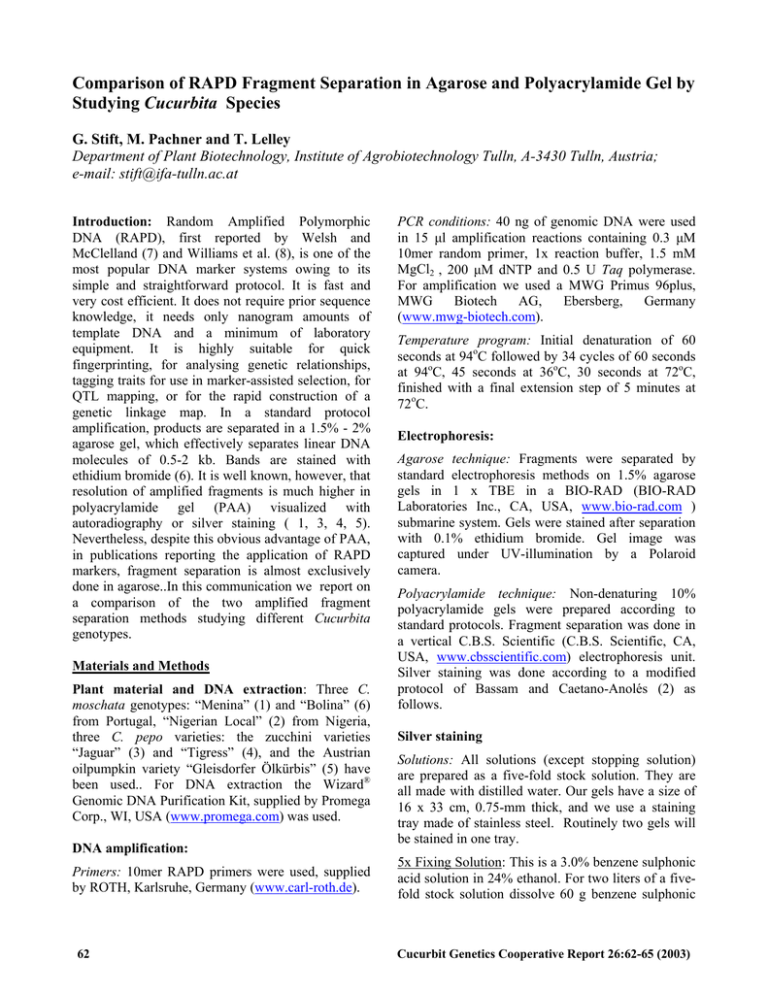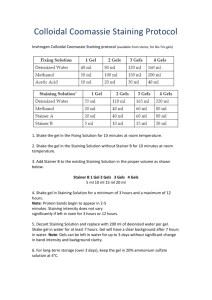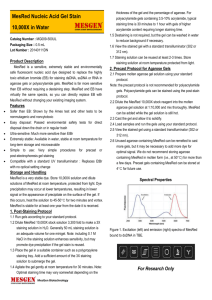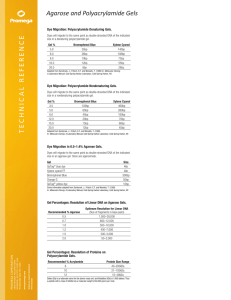Comparison of RAPD Fragment Separation in Agarose and Polyacrylamide Gel... Cucurbita
advertisement

Comparison of RAPD Fragment Separation in Agarose and Polyacrylamide Gel by Studying Cucurbita Species G. Stift, M. Pachner and T. Lelley Department of Plant Biotechnology, Institute of Agrobiotechnology Tulln, A-3430 Tulln, Austria; e-mail: stift@ifa-tulln.ac.at Introduction: Random Amplified Polymorphic DNA (RAPD), first reported by Welsh and McClelland (7) and Williams et al. (8), is one of the most popular DNA marker systems owing to its simple and straightforward protocol. It is fast and very cost efficient. It does not require prior sequence knowledge, it needs only nanogram amounts of template DNA and a minimum of laboratory equipment. It is highly suitable for quick fingerprinting, for analysing genetic relationships, tagging traits for use in marker-assisted selection, for QTL mapping, or for the rapid construction of a genetic linkage map. In a standard protocol amplification, products are separated in a 1.5% - 2% agarose gel, which effectively separates linear DNA molecules of 0.5-2 kb. Bands are stained with ethidium bromide (6). It is well known, however, that resolution of amplified fragments is much higher in polyacrylamide gel (PAA) visualized with autoradiography or silver staining ( 1, 3, 4, 5). Nevertheless, despite this obvious advantage of PAA, in publications reporting the application of RAPD markers, fragment separation is almost exclusively done in agarose..In this communication we report on a comparison of the two amplified fragment separation methods studying different Cucurbita genotypes. Materials and Methods Plant material and DNA extraction: Three C. moschata genotypes: “Menina” (1) and “Bolina” (6) from Portugal, “Nigerian Local” (2) from Nigeria, three C. pepo varieties: the zucchini varieties “Jaguar” (3) and “Tigress” (4), and the Austrian oilpumpkin variety “Gleisdorfer Ölkürbis” (5) have been used.. For DNA extraction the Wizard® Genomic DNA Purification Kit, supplied by Promega Corp., WI, USA (www.promega.com) was used. DNA amplification: Primers: 10mer RAPD primers were used, supplied by ROTH, Karlsruhe, Germany (www.carl-roth.de). 62 PCR conditions: 40 ng of genomic DNA were used in 15 µl amplification reactions containing 0.3 µM 10mer random primer, 1x reaction buffer, 1.5 mM MgCl2 , 200 µM dNTP and 0.5 U Taq polymerase. For amplification we used a MWG Primus 96plus, MWG Biotech AG, Ebersberg, Germany (www.mwg-biotech.com). Temperature program: Initial denaturation of 60 seconds at 94oC followed by 34 cycles of 60 seconds at 94oC, 45 seconds at 36oC, 30 seconds at 72oC, finished with a final extension step of 5 minutes at 72oC. Electrophoresis: Agarose technique: Fragments were separated by standard electrophoresis methods on 1.5% agarose gels in 1 x TBE in a BIO-RAD (BIO-RAD Laboratories Inc., CA, USA, www.bio-rad.com ) submarine system. Gels were stained after separation with 0.1% ethidium bromide. Gel image was captured under UV-illumination by a Polaroid camera. Polyacrylamide technique: Non-denaturing 10% polyacrylamide gels were prepared according to standard protocols. Fragment separation was done in a vertical C.B.S. Scientific (C.B.S. Scientific, CA, USA, www.cbsscientific.com) electrophoresis unit. Silver staining was done according to a modified protocol of Bassam and Caetano-Anolés (2) as follows. Silver staining Solutions: All solutions (except stopping solution) are prepared as a five-fold stock solution. They are all made with distilled water. Our gels have a size of 16 x 33 cm, 0.75-mm thick, and we use a staining tray made of stainless steel. Routinely two gels will be stained in one tray. 5x Fixing Solution: This is a 3.0% benzene sulphonic acid solution in 24% ethanol. For two liters of a fivefold stock solution dissolve 60 g benzene sulphonic Cucurbit Genetics Cooperative Report 26:62-65 (2003) acid in 480 ml of ethanol absolute. This yellow colored solution is filled up to two liters with water. Remaining particles do not disturb the staining procedure. Solution can be kept at room temperature. (acc. to the protocol from Pharmacia Biotech DNA silver staining kit: Amersham-Pharmacia Biotech, cat.nr. 17-6000-30). For staining mix 100 ml of this 5x fixing solution with 400 ml of 24% ethanol. 5x Silver Solution: Prepare a 2% silver nitrate solution by dissolving 10 g AgNO3 in 500 ml A.dest. Keep this solution in a dark bottle at room temperature. For staining take 50 ml of 2% AgNO3, add 11.66 ml 5x fixing solution and fill up to 500 ml with water. 5x Developer: Dissolve 312.5 g sodium carbonate in 1.5 l water and fill up to 2 l. For a faster dissolving of the powder stir it on a hot magnetic stirring plate. Keep the solution at room temperature, over 15°C. At lower temperatures, the sodium carbonate will cristallize. For staining take 100ml of the 5x Developer Solution and fill it up to 500 ml with water. Cool this solution to +4°C in the fridge. Just before use, add to this solution 1.000 µl 37% formaldehyde and 1.000µl 2% sodium thiosulphate. 2% sodium thiosulphate is made by dissolving 2 g sodium thiosulphate in water and filled up to 100 ml. Stopping solution: It is a 7.5% acetic acid solution. To 925 ml water add 75 ml acetic acid 99%. Keep this Solution at +4°C. Additional water will be needed for washing steps. Shaking of gels during the staining procedure is carried out with an orbital Shaker such as HOEFER Red Rotor (Amersham-Pharmacia Biotech, cat.nr. 80-6097-10, http://www.apbiotech.com). Method: The staining protocol is shown in Table 1. The times are given for 0.75-mm thick gels and may vary for gels with other thickness. Avoid touching the gels by hand or unwashed, powdered gloves. Otherwise brown spots or dots will appear on the gel. Never let the gel dry out during the staining. The developing solution, containing formaldehyde is unstable and therefore the formaldehyde should be added immediately before use. During development it is necessary to watch the gel. Do not use warm developer, this will lead to a too fast development and strong background. We recommend to prepare during the development a second tray with the stopping solution. Take out the properly developed Cucurbit Genetics Cooperative Report 26:62-65 (2003) gel, put it into the stop solution and stop the development of each gel individually. For an immediate stop of developing reaction it is necessary to use a cold (+4°C) stopping solution. Storage of the gels: put the gel on a sheet of normal white paper and cover it with a piece of an overhead foil. This sandwich is dried in a HOEFER SE 1160 Drygel Sr. Vacuum Gel Dryer System (AmershamPharmacia Biotech, Cat. No. 80-6119-33). Drying of two gels normally needs 1.5 hours. Carefully dried gels can be stored for years. To recover the silver of the silver nitrate solution we precipitate the used solution with NaCl (VWR, cat.nr. 106404, for analysis), then filter it through Whatman 1 (pore size 11µm, Cole-Parmer, Vernon Hills, IL 60061-1844, U.S.A.). Collect all used solutions and dispose them properly. Dried gels were scanned for further evaluation. Results and Discussion: In Figure 1 two examples, comparing the two techniques, are given. Comparison of the size marker shows the different distances in which fragments are separated in the two media, resulting in a better resolution of the bands in PAA. It has to be observed that the proportion of distances are not comparable. Duplex DNA migrates at rates that are inversely proportional to the log 10 of their size. However, while in PAA electrophoretic mobility is also affected by base composition and sequence, DNAs of exactly the same size can differ in mobility by up to 10%, in agarose only the number of base pairs matters (5). In summary, separation of RAPD amplification products in PAA instead of agarose results in the following advantages: (1) More bands are produced, even though reproducibility of weak bands is not improved. (2) Band separation is clearer: single bands are often resolved in two bands, leading to an increase of polymorphic bands.(3) Less DNA and PCR reaction ingredients are needed. (4) Better cost efficiency due to the lower price for PAA compared to agarose (Calculation of the cost per lane revealed an almost 60% lower price for PAA than for agarose). (5) The use of mutagenic ethidium bromide is avoided. (6) The original PAA gels can be stored indefinitely. 63 Fig.1: Corresponding sections of an agarose and an acrylamide gel loaded with the same amplification products 1 to 6 as listed in material and methods. Size marker is in both cases: pBR322/MspI + BstNI. Bands are numberd (italic) correspondingly to enable a better comparison. A: The resolution in PAA is much higher especially below 400bp. The single polymorphic band in lane 3, 4 and 5 at 190bp is not visible on the agarose gel. Fragment 6 seems to be a single band on agarose, in PAA it is resolved in two, the weaker band being polymorphic in lane 3 and 5. B: On PAA there are clear double bands at ~1000bp and at ~400bp (1,4) which are not visible on the agarose gel. 64 Cucurbit Genetics Cooperative Report 26:62-65 (2003) Table1. Silver staining protocol. Step Solution Time Fixing Fixer Solution 30 min Staining Staining Solution 30 min Wash A.bidest 1 min Developing Developer 4-10 min Stop Stopping Solution 3 min Rinse A.bidest 3 min Literature Cited 1. Bassam, B.J., G. Caetano-Anollés, and P.M. Gresshoff, 1991: A fast and sensitive silverstaining for DNA in polyacrylamide gels. Analytical Biochemistry 196, 80-83. 5. Sambrook, J., and D.W. Russell, 2001: Polyacrylamide Gel Electrophoresis. In: Molecular Cloning. A Laboratory Manual. Third edition. Cold Spring Harbor Laboratory Press. 2. Bassam B.J., and G. Caetano-Anollés, 1993: Silver staining of DNA in polyacrylamide gels. App. Biochem. Biotechn. 42, 181-188. 6. Sharp, P.A., B. Sugden, and J. Sambrook, 1973: Detection of two restriction endonuclease activities in Haemophilus parainfluencae using analytical agarose-ethidium bromide electrophoresis. Biochemistry 12, 3055. 3. Edwards, K.J. 1998: Randomly amplified polymorphic DNAs (RAPDs). In: A. Karp, P.G. Isaac, and D.S. Ingram (Eds.) Molecular tools for Screening Biodiversity. Chapman & Hall London, 171-174. 4. Penner, G.A., and L.J. Bezte, 1994: Increased detection of polymorphism among randomly amplified wheat DNA fragments using a modified temperature sweep gel electrophoresis (TSGE) technique. Nucleic Acids Research 22, 1780-1781. 7. Welsh, J., and M. McClelland, 1991: Genomic fingerprinting using arbitrarily primed PCR and a matrix of pairwise combinations of primers. Nucleic Acids Research 19, 5275-5280. 8. Williams, J.G.K., Kubelik, A.R., Livak, K.J., Rafalski, J.A., and S.V. Tingey, 1990: DNA polymorphisms amplified by arbitrary primers are useful as genetic markers. Nucl. Acids Res. 18, 6531-6535. A Cucurbit Genetics Cooperative Report 26:62-65 (2003) 65







